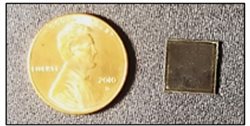
Researchers at the University of Illinois Urbana-Champaign have created a high-voltage micro-battery with energy and power density levels unparalleled by any existing battery design. According to the research team, the new battery could be used to power microdevices, microrobots and implantable medical devices.
The team demonstrated hermetically sealed (tightly closed to prevent exposure to ambient air), durable, compact, lithium batteries with exceptionally low package mass fraction in single-, double-, and triple-stacked configurations with unprecedented operating voltages, and high power and energy densities.
‘We need powerful tiny batteries to unlock the full potential of microscale devices, by improving the electrode architectures and coming up with innovative battery designs,’ explained Professor Paul Braun, the Grainger distinguished chair in engineering and director of the Materials Research Laboratory Braun. The problem is that as batteries become smaller, the packaging dominates the battery volume and mass, while the electrode area becomes smaller, which results in drastic reductions in the energy and power of the battery.
In their unique design, the team developed novel packaging technology that used the positive and negative terminal current collectors as part of the packaging itself, rather than being a separate entity. This allowed for the batteries’ compact volume – less than 0.165 cubic centimetres – and low package mass fraction of just 10.2 per cent. In addition, they vertically stacked the electrode cells in series, so that the voltage of each cell is combined, which enabled the high operating voltage of more than nine volts.
Another improvement involved the use of very dense electrodes, which boosted energy density. In normal electrodes, almost 40 per cent of the volume is occupied by polymers and carbon additives, rather than active materials. Braun’s group grew electrodes that had no polymer or carbon additives using an intermediate-temperature direct-electrodeposition technique. These fully dense electrodes offer more volumetric energy density than their commercial counterparts.
‘To date, electrode architectures and cell designs at the micro-nano scale have been limited to power-dense designs that came at the cost of porosity and volumetric energy density,’ said graduate student Arghya Patra. ‘Our work has been successful to create a microscale energy source that exhibits both high power density and volumetric energy density.’
Potential applications for the novel micro-batteries include powering insect-size microrobots to obtain valuable information during natural disasters, search and rescue missions, and in hazardous environments where direct human access is impossible. ‘The high voltage is important for reducing the electronic payload that a microrobot needs to carry,’ said James Pikul, an assistant professor in the Department of Mechanical Engineering and Applied Mechanics at the University of Pennsylvania.
According to Pikul, nine volts can directly power motors and reduce the energy loss associated with boosting the voltage to the hundreds or thousands of volts needed from some actuators. ‘This means that these batteries enable system-level improvements beyond their energy density enhancement so that the small robots can travel farther or send more critical information to a human operator,’ he said.
‘Our work bridges the knowledge gap at the intersection of materials chemistry, unique materials manufacturing requirements for energy dense planar micro-battery configurations, and applied nano-microelectronics that require a high-voltage, on-board-type power source to drive micro-actuators and micromotors,’ said postdoc Sungbong Kim.
‘Our current micro-battery design is well suited for high-energy, high-power, high-voltage, single-discharge applications,’ concluded Braun. ‘The next step is to translate the design to all solid-state micro-battery platforms – batteries that would inherently be safer and more energy dense than liquid-cell counterparts.’
The research has been published in Cell Reports Physical Science.


